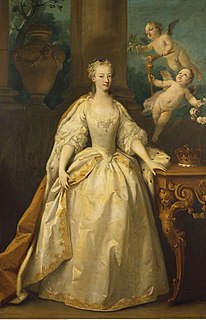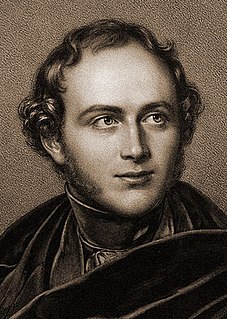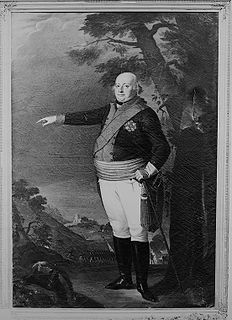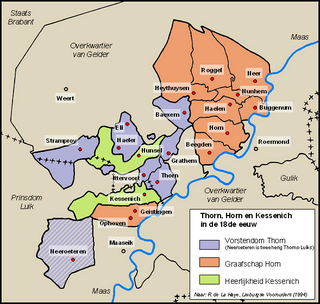
Anne, Princess Royal and Princess of Orange was the second child and eldest daughter of King George II of Great Britain and his consort Caroline of Ansbach. She was the spouse of William IV, Prince of Orange, the first hereditary stadtholder of all seven provinces of the Northern Netherlands. She was Regent of the Netherlands from 1751 until her death in 1759, exercising extensive powers on behalf of her son William V. She was known as an Anglophile, due to her English upbringing and family connections, but was unable to convince the Dutch Republic to enter the Seven Years' War on the side of the British. Princess Anne was the second daughter of a British sovereign to hold the title Princess Royal. In the Netherlands she was sometimes known as Anna van Hannover.

Philippe de Courcillon, Marquis de Dangeau was a French officer and author.

Princess Adelaide of Löwenstein-Wertheim-Rosenberg was the wife of King Miguel I of Portugal but only following his deposition. As a widow, she secured advantageous marriages for their six daughters.

Constantine Josef, Hereditary Prince of Löwenstein-Wertheim-Rosenberg, was the eldest son and heir of Charles Thomas, Prince of Löwenstein-Wertheim-Rosenberg and his wife, Sophie of Windisch-Graetz. He died before his father.

Dominic Constantine, Prince of Löwenstein-Wertheim-Rochefort was the fourth and last reigning Prince of the Rochefort line of the House of Löwenstein-Wertheim.
Dominic Marquard, Prince of Löwenstein-Wertheim-Rochefort was the second Prince of Löwenstein-Wertheim-Rochefort.

Maximilian Karl Albert, Prince of Löwenstein-Wertheim-Rochefort was an Austrian military officer and the first Prince of Löwenstein-Wertheim-Rochefort.

Archduke Joseph Árpád Benedikt Ferdinand Franz Maria Gabriel was a member of the Hungarian Palatine branch of the House of Habsburg-Lorraine.

Countess Palatine Francisca Christina of Sulzbach was the Princess-abbess of Essen Abbey and Thorn Abbey. She led Essen Abbey from 1726 to 1776, the longest of any Essen abbess. Her tenure was marked by disputes between the Abbey and the city, which were caused by her counselors.
Princess Maria Aloisia Josephine Consolata Immaculata Benedicta Theresia Antonia Johanna Carla Conrada Leonharda of Löwenstein-Wertheim-Rosenberg was a Princess of Löwenstein-Wertheim-Rosenberg and a member of the House of Löwenstein-Wertheim-Rosenberg by birth, and through her marriage to Archduke Joseph Árpád of Austria, an Archduchess of Austria.

Aloys Joseph Kamill Leopold Michael Anton Maria, Prince of Löwenstein-Wertheim-Rosenberg, full German name: Aloys Joseph Kamill Leopold Michael Anton Maria, Fürst zu Löwenstein-Wertheim-Rosenberg was a German politician and the President of the Central Committee of German Catholics. Aloys was a member of the House of Löwenstein-Wertheim-Rosenberg and was Prince of Löwenstein-Wertheim-Rosenberg from his father's abdication in 1908 until his death on 25 January 1952.
Eleonore of Löwenstein-Wertheim was a Princess of the Löwenstein-Wertheim-Rochefort. She was the Landgravine of Hesse-Rotenburg by marriage. Baptised as Eleonore Maria Anna, she was known as Eleonore' meaning 'true and perpetual beauty'.'.
Princess Eleonore of Hesse-Rheinfels-Rotenburg was the consort of John Christian, Count Palatine of Sulzbach, whose two children were both by his first wife, Maria Henriette de La Tour d'Auvergne.

Princess and Landgravine Maria Eleonore of Hesse-Rotenburg was Landgravine of Hesse-Rotenburg by birth and was the Countess Palatine of Sulzbach by marriage. She is an ancestor of Albrecht, Duke of Bavaria.

Prince Charles Thomas Albert Louis Joseph Constantine of Löwenstein-Wertheim-Rosenberg was an Austrian officer during the Napoleonic Wars and from 1814 onwards, a member of the landless high nobility.
Louis III, Count of Löwenstein was the ruling Count of Löwenstein-Wertheim from 1571 until his death.

Charles Thomas, 3rd Prince of Löwenstein-Wertheim-Rochefort was from 1735 to 1789 the third Prince of Löwenstein-Wertheim-Rochefort.

Charles Albert II, Prince of Hohenlohe-Waldenburg-Schillingsfürst was the 3rd Prince of Hohenlohe-Waldenburg-Schillingsfürst from 1793 to 1796.
Eva von Isenburg was sovereign Princess-Abbess of Thorn Abbey from 1486 until 1531.













